NDVI stands for "Normalized Difference Vegetation Index". NRG stands for "Near-infrared / Red / Green". NDVI and NRG are both ways to visualize the amounts of infrared and other wavelengths of light reflected from vegetation. Because both these methods compare ratios of blue and red light absorbed versus green and IR light reflected, they can be used to evaluate the health of vegetation. It's a snapshot of how much photosynthesis is happening. This is helpful in assessing vegetative health or stress. (Read more here: https://www.agronomy.org/publications/jeq/articles/36/3/832) ## Do-It-Yourself These techniques for vegetation analysis were developed for satellite imagery, but at Public Lab, we've been working a lot on capturing infrared imagery using our DIY [near-infrared camera](/wiki/near-infrared-camera) setup, and combining it with visible bands to produce NDVI images such as the one above. ## What these images mean What exactly are these images we're trying to make? What do they tell us about vegetation, and why? These diagrams should help to understand what it is we're doing and why these are good ways to analyze plant life. ## The NDVI equation [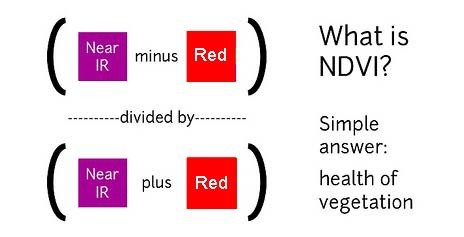](/i/44723) **NDVI = (Near Infrared - Red)/(Near Infrared + Red)** NDVI is a ratio which tries to emphasize photosynthesis while filtering out sun glare. The above equation is run for every pixel, using source data from an infrared photo and a visible light photo, like this pair: [](https://publiclab.org/system/images/photos/000/021/771/original/5390895115_c9d4d38fec_o.jpg) The result can be false-colored to make the high-photosynthesis areas more clear, and used to examine where plants are and how healthy they are. [](https://publiclab.org/system/images/photos/000/021/770/original/PetVISNDVIcomp.png) _Figure above: Normal color photo (right) and normalized difference vegetation index (NDVI) image (left). NDVI image was derived from two color channels in a single photo taken with a camera modified with a special infrared filter. Note that tree trunks, brown grass, and rocks have very low NDVI values because they are not photosynthetic. Healthy plants typically have NDVI values between 0.1 and 0.9. -- @cfastie_ ### Activities Here are a range of activities you can do to produce and interpret your own NDVI imagery, whether downloaded from a satellite imagery provider or [collected yourself using a DIY technique](/wiki/multispectral-imaging) [activities:ndvi] ****   Most DIY converted cameras today (those from Public Lab) use RGN instead of NRG, so the blue channel represents infrared instead of the red channel. That looks like this: [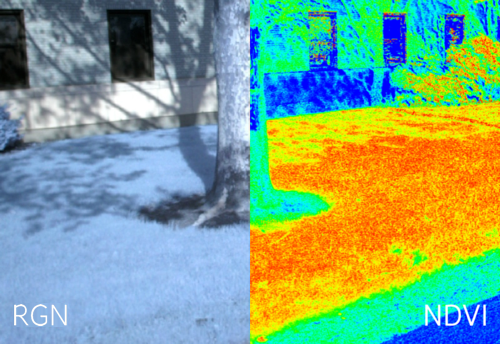](/i/45468?s=o) **** ## NRG imagery Some people are also interested in producing NRG imagery (like the below image), where `Near-Infrared, Red, and Green` are used to compose a picture instead of the usual `Red, Green, and Blue`. [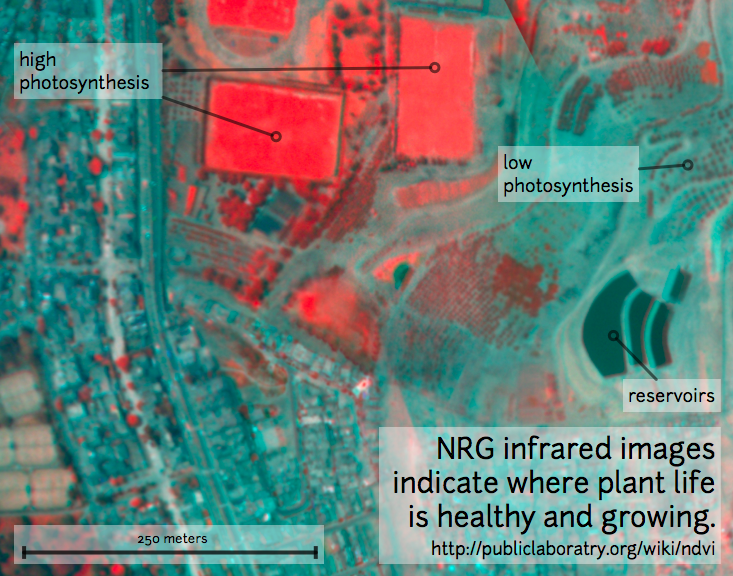](/i/25064) This diagram explains the swapping, which allows us to 'see' infrared as if it were a normal color: [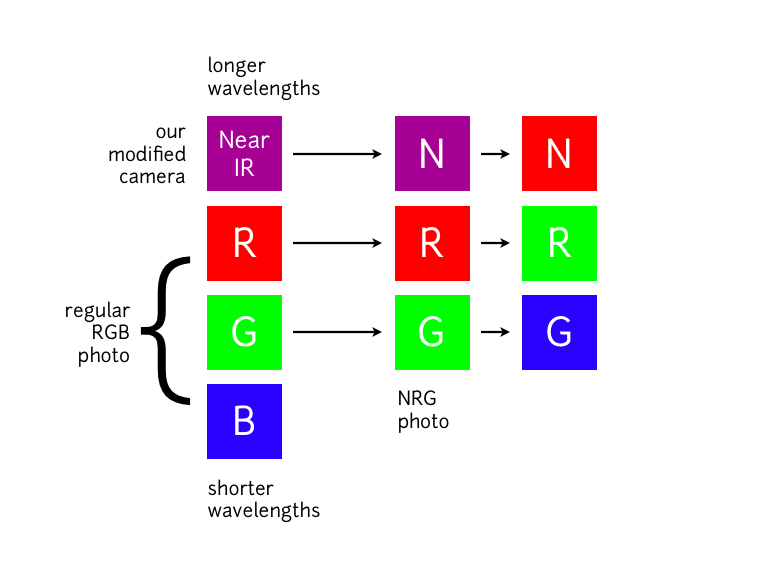](/i/25063) **In NRG images, the deeper and clearer the red color, the denser and healthier the vegetation (more or less).** ### Questions [questions:ndvi] ### Other examples of DIY NDVI imaging From around the internet: Begin watching at 2 minutes to see the resulting imagery: *This topic is part of the [Grassroots Mapping Curriculum](/wiki/mapping-curriculum) series.* **** [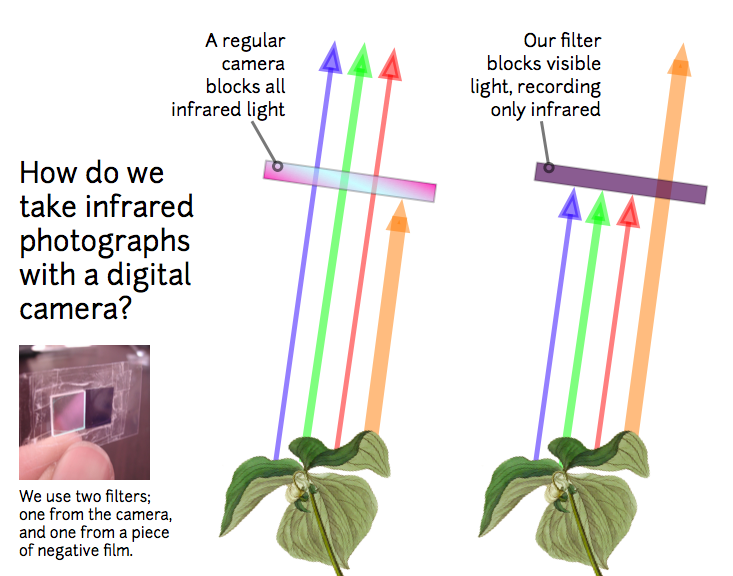](/i/25066) [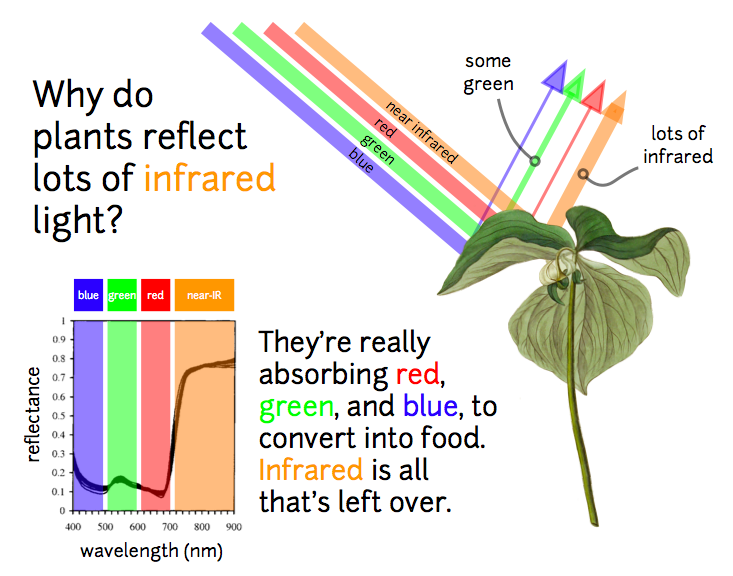](/i/25065) ...
| Author | Comment | Last activity | Moderation | ||
|---|---|---|---|---|---|
| ankurp836 | " Thanks for buddy Post " | Read more » | over 5 years ago | |||
| warren | "that'd be awesome. The image workflow we've built is javascript based, but it's also possible to use Pi Builder to produce reproducible python tool..." | Read more » | over 5 years ago | |||
| petter_mansson1 | " I was not aware of this. Very cool, I had an idea doing something of the same sort but it's better if we work together! I'd love to share what I'v..." | Read more » | over 5 years ago | |||
| warren | " Hi! This is awesome. Have you seen our Infragram Pi software, somewhat documented at: https://publiclab.org/infragram-pi https://publiclab.org/p..." | Read more » | over 5 years ago | |||
| Bronwen | " This is fantastic! Looking forward to seeing your conclusions! " | Read more » | over 5 years ago | |||
| warren | "I posted an activity for doing NDVI-like work using a camera like this -- with a coefficient (on the output of NDVI, so like "boosted" NDVI) here: ..." | Read more » | over 6 years ago | |||
| tech4gt | "@jywarren this is awesome!!! :D " | Read more » | over 6 years ago | |||
| warren | "Probably! Can you point me at a MODIS source with bands youre interested in? " | Read more » | over 6 years ago | |||
| eustatic | "hunh, can you do this with MODIS? " | Read more » | over 6 years ago | |||
| ccpandhare | "@warren wow this looks very promising!! :-D " | Read more » | over 6 years ago | |||
| jbreen | "@warren I think you may have stumped me. Have you looked at GloVis? glovis.usgs.gov " | Read more » | over 6 years ago | |||
| warren | "@wward1400 @adam-griffith @MicheleTobias @lprashad @eustatic @nedhorning @cfastie you might like this little experiment too! " | Read more » | over 6 years ago | |||
| warren | "@ccpandhare @tech4gt exciting! @jbreen - you'd know this... are there any tiles available for LANDSAT's near-infrared bands? Especially like NGB t..." | Read more » | over 6 years ago | |||
| warren | "Ah! https://publiclab.org/notes/cfastie/08-20-2013/white-balance-recovery Flashback! " | Read more » | almost 7 years ago | |||
| warren | "I guess to evaluate how well the 2x blue boost I posted above worked, we'd have to compare it to a better system, right? If other folks take a phot..." | Read more » | almost 7 years ago | |||
| cfastie | "I have tried several times to adjust the histogram of bad infrared photos. It has always failed and I don't know why. I assume it is because the ad..." | Read more » | almost 7 years ago | |||
| warren | "Hmm, could we manually multiply the blue channel by 2 or 3 to do a "post-processed white balance"? Of course this would need to be calibrated, but ..." | Read more » | almost 7 years ago | |||
| cfastie | "A single camera NDVI system with a red filter should produce a photo with very turquoise foliage. The blue channel (NIR) should be much brighter th..." | Read more » | almost 7 years ago | |||
| warren | "Incandescent white balance seems to work all right! But wait, here it is in NDVI using http://infragram.org -- black is zero NDVI, white is 1.0: ..." | Read more » | almost 7 years ago | |||
| warren | "@amanda and I did a take apart session and this is pretty easy to do with a good pair of pliers -- wire strippers worked well! " | Read more » | almost 7 years ago | |||
| warren | "Does anyone have some more photos of this conversion process we could show here, more step-by-step? " | Read more » | about 7 years ago | |||
| cfastie | "The new filter can be inside the camera or in front of the lens. If it is in front, it will get scratched and might be bent (not flat), but it is e..." | Read more » | about 7 years ago | |||
| rrstrauss | "@azaelb There's something I don't really get. Basically what we need to do is to remove the ir cutter from inside the camara and place the red filt..." | Read more » | about 7 years ago | |||
| warren | "Also see this page collecting cheap cameras of this type: https://publiclab.org/questions/warren/05-20-2017/cheap-lightweight-gopro-alternatives-fo..." | Read more » | over 7 years ago |